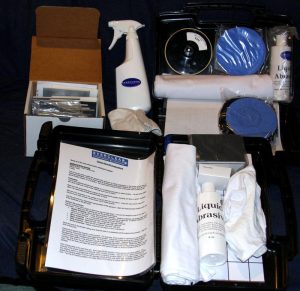In our first issue for the new year we present part 1 of a paper entitled, Granular Activated Carbon: Modeling of Operational Parameters for Dissolved Organic Carbon Removal from Marine Aquaria, by Ken S. Feldman, Lauren F. Vernese, Karl T. Mueller, and Kelly Maers, from the Chemistry Department, The Pennsylvania State University. I’m particularly excited about this study because it applies hard science to a subject that has had enumerable anecdotal observations about why, how, how much, and how often to use activated carbon in marine aquaria. Because the observations were anecdotal they were contradictory, if not simply filled with misinformation. With this study we now have some quantifiable data. For lay people the paper in its entirety may be a little tough reading, but with some mental sweat the reader will find some very valuable information about the use of activated carbon.
Scratches and Acrylic Aquaria
Keeping a large reef tank that is made of acrylic is far more difficult than I had imagined. I was warned by some of my reef keeping friends that keeping coralline algae off of the front pane would be a burden — I must admit that they were right. Essentially, I had little choice: I couldn’t find anyone that would build a glass reef tank on location, and the configuration of my house made it impossible to bring a glass reef tank of the size I wanted into the only location available to me. As far as the animals are concerned a glass or acrylic cage is irrelevant, but to me keeping the coralline off of the front pane is extremely difficult. And, as some of you know I have experimented with plastic blades and a variety of tools, which to some degree work, but nonetheless, I frequently scratch the acrylic front pane both inside and out. To exacerbate the problem coralline algae apparently loves to attach to plastic, and especially to scratches in the plastic. What to do about this,
is the question. One answer follows.
A company called Everclear Transparency Refurbishing, Inc. seems to have the best solution I’ve seen so far. The following exchange took place with me and them very recently:
From: Scott Berentsen [mailto:[email protected]]
Sent: Saturday, January 05, 2008 11:10 AM
To: terry siegel
Subject: Re: Follow-upTerry,
Good to hear it works well on the outside. As for the inside, I originally sent you a Magnet Kit that works with any Magnavore magnet. This is a very popular kit because it allows you to remove the inside scratches while keeping the reef intact. We have developed the same kit to work with Algae Free magnets as well.
Tips, first try and remove the deepest scratches, either by hand or using the magnet. If there are a lot of scratches throughout, you may just want to refurbish the entire panel. Take a look at the magnet kit instructions and let me know if you have any questions.
By the way, we use the magnet scratch removal system in our commercial services and it works well. As with any scratch removal, it does require quite a bit of time and energy.
For the future, we are working on some innovative solutions. First, for the outside, we are now offering a protective film that serves as a sacrificial, replaceable layer. Eventually we’ll be offering it for the inside as well. We are also doing R&D on some tools that will make scratch removal more automated.
Regards, Scott
Everclear Transparency Refurbishing Inc.
[email protected]
www.etr-inc.com
512-301-7562Hi Scott,
Yesterday I finally got around to using your underwater kit, and much to my amazement it worked quite well. Hair line scratches, which represent the vast majority, which resulted from coralline algae removal, were relatively easily removed using the Magnet Kit. A few deeper scratches required a lot of elbow grease, with the result that I’m looking forward to your R&D results.
Terry Siegel, Editor











0 Comments